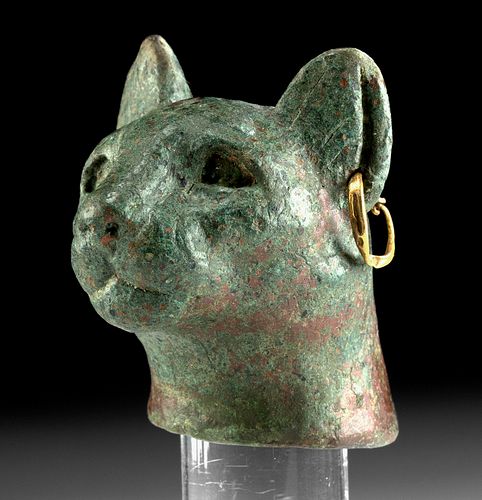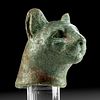Egyptian Bronze Cat Head w/ Gold Earring
Lot 2a
About Seller
Artemis Fine Arts
686 S Taylor Ave, Ste 106
Louisville, CO 80027
United States
Selling antiquities, ancient and ethnographic art online since 1993, Artemis Gallery specializes in Classical Antiquities (Egyptian, Greek, Roman, Near Eastern), Asian, Pre-Columbian, African / Tribal / Oceanographic art. Our extensive inventory includes pottery, stone, metal, wood, glass and textil...Read more
Estimate:
$13,500 - $20,000
Absentee vs Live bid
Two ways to bid:
- Leave a max absentee bid and the platform will bid on your behalf up to your maximum bid during the live auction.
- Bid live during the auction and your bids will be submitted real-time to the auctioneer.
Bid Increments
| Price | Bid Increment |
|---|---|
| $0 | $25 |
| $300 | $50 |
| $1,000 | $100 |
| $2,000 | $250 |
| $5,000 | $500 |
| $10,000 | $1,000 |
| $20,000 | $2,500 |
| $50,000 | $5,000 |
| $100,000 | $10,000 |
| $200,000 | $20,000 |
About Auction
By Artemis Fine Arts
Mar 24, 2022
Set Reminder
2022-03-24 10:00:00
2022-03-24 10:00:00
America/New_York
Bidsquare
Bidsquare : Exceptional Antiquities Ethnographic Fine Art
https://www.bidsquare.com/auctions/artemis-gallery/exceptional-antiquities-ethnographic-fine-art-9057
Museum-worthy examples of classical antiquities (Egyptian, Greek, Roman, Near Eastern), Viking, Far East / Asian, Pre-Columbian, African / Tribal, Oceanic, Native American, Spanish Colonial, Fossils, Ancient Jewelry, Fine / Visual Arts, so much more! Artemis Fine Arts info@artemisgallery.com
Museum-worthy examples of classical antiquities (Egyptian, Greek, Roman, Near Eastern), Viking, Far East / Asian, Pre-Columbian, African / Tribal, Oceanic, Native American, Spanish Colonial, Fossils, Ancient Jewelry, Fine / Visual Arts, so much more! Artemis Fine Arts info@artemisgallery.com
- Lot Description
Ancient Egypt, Third Intermediate to early Late Dynastic Period, 21st to 26th Dynasty, ca. 1070 to 525 BCE. A gorgeous cast-bronze head of a cat with a charming countenance accentuated with a lightweight 79.28% gold hoop earring. Of hefty form and covered in thick layers of brown, green, and russet patina, the precious feline exhibits a short snout with a petite nose, lightly rounded jowls above a rolled chin, and lightly furrowed brows above hollow ocular cavities; remains of bituminous material suggests the eyes once held inlays of precious stones or precious metals. A pair of perky ears rises from atop the smooth skullcap, and one ear is adorned with a lustrous gold earring. Size: 2.02" L x 1.42" W x 1.77" H (5.1 cm x 3.6 cm x 4.5 cm); 4.25" H (10.8 cm) on included custom stand; gold quality: 79.28% (equivalent to 18K+)
The ancient Egyptians, rather uniquely among the world's civilizations, had an obsession with cats, both tame and fierce, large and small. Cats were domesticated to help protect crops from pests in Cyprus or possibly Mesopotamia (it is difficult to interpret the archaeological record on this matter for a variety of reasons), but the Egyptian love of cats seems to have gone above and beyond that of their contemporaries. The cemetery at Hierakonpolis includes a cat skeleton in a pre-Dynastic tomb (ca. 3700 BCE) that had a broken left humerus and right femur that seem to have been set by a human and allowed to heal before that cat's ultimate death. The first illustration of a cat with a collar comes from a 5th Dynasty (ca. 2500 to 2350 BCE) Egyptian tomb at Saqqara. Cats were the most frequently mummified animal in Egypt and there were multiple feline goddesses, including the domesticated cat-form Bastet.
Bastet was initially a lioness goddess associated with the solar god and channeled its destructive power. However, by the early first millennium BCE, she assumed a more domestic feline form and became understood as a goddess of fertility and a guardian of the home. Ever since, statuettes comprised of various materials have characterized her as a doting mother cat. Her cult expanded decisively when her town in Bubastis (derived from per Bastet or "house of Bastet"), became the royal residence of the kings of the 22nd Dynasty, during the 10th century BCE. The city hosted an annual festival honoring Bastet in celebration of the Nile flood waters, and she was honored throughout Egypt through the first millennium BCE.
Cf. The Metropolitan Museum of Art, accession number 86.1.80
A similar example with a scarab atop its head hammered for GBP 25,000 ($32,503.62) at Christie's, London "Antiquity: A Personal View" auction (Online 19504, July 6-27, 2020, lot 108)
Provenance: private New York, USA collection; ex-Willy Dreyfus collection, thence by inheritance
All items legal to buy/sell under U.S. Statute covering cultural patrimony Code 2600, CHAPTER 14, and are guaranteed to be as described or your money back.
A Certificate of Authenticity will accompany all winning bids.
PLEASE NOTE: Due to recent increases of shipments being seized by Australian & German customs (even for items with pre-UNESCO provenance), we will no longer ship most antiquities and ancient Chinese art to Australia & Germany. For categories of items that are acceptable to ship to Australia or Germany, please contact us directly or work with your local customs brokerage firm.
Display stands not described as included/custom in the item description are for photography purposes only and will not be included with the item upon shipping.
#170813Restoration to back of neck and areas behind head, with resurfacing, overpainting, and repatination along new material and break lines. Loss to eye inlays as shown. Minor abrasions and nicks as shown, with softening to some finer details, slight bending to gold earring, and light encrustations. Wonderful patina throughout, and great preservation to feline form.Condition
- Shipping Info
-
All shipping is handled in-house for your convenience. Your invoice from Artemis Gallery will include shipping calculation instructions. If in doubt, please inquire BEFORE bidding for estimated shipping costs for individual items.
-
- Buyer's Premium



 EUR
EUR CAD
CAD AUD
AUD GBP
GBP MXN
MXN HKD
HKD CNY
CNY MYR
MYR SEK
SEK SGD
SGD CHF
CHF THB
THB















